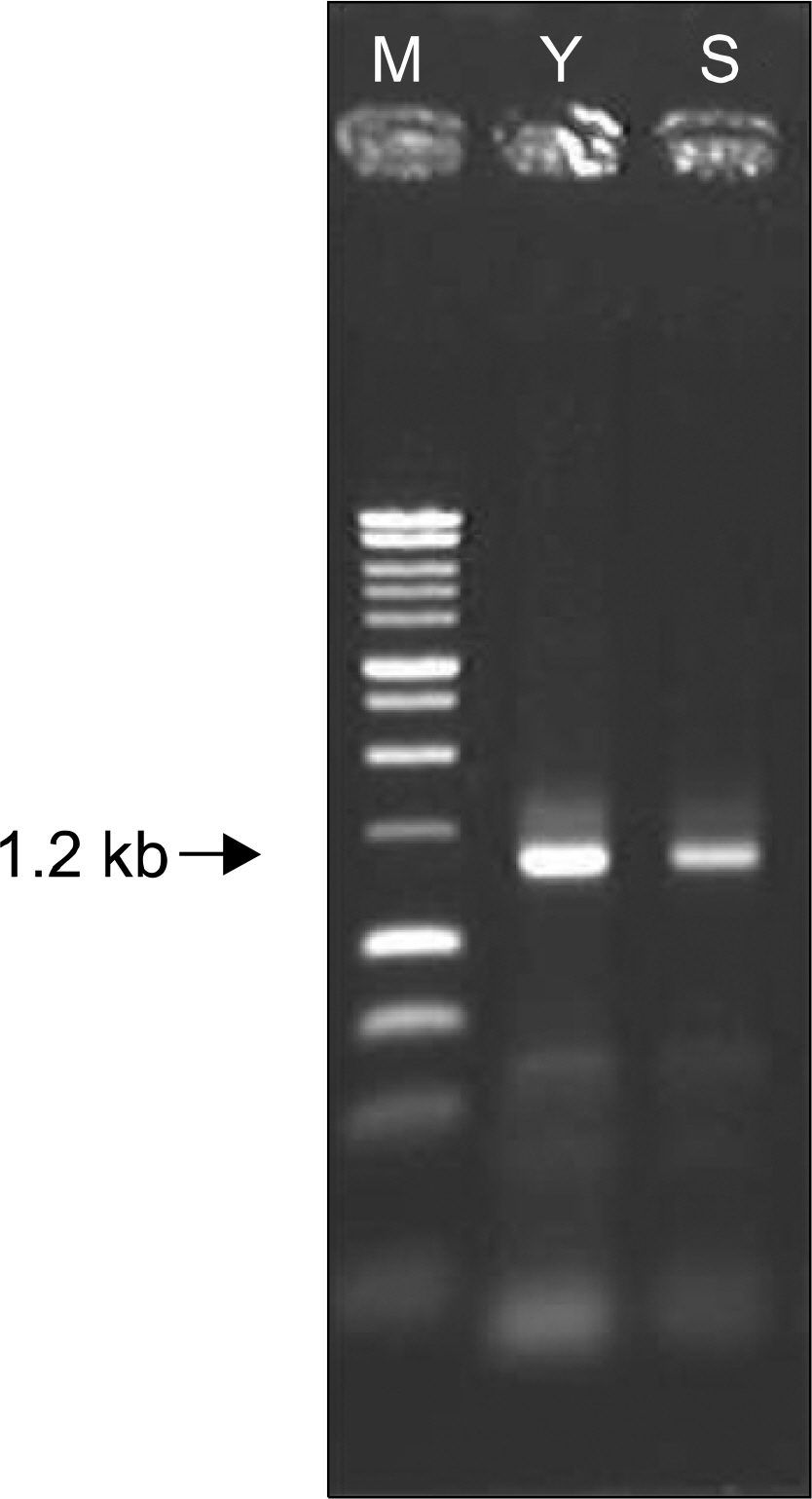Korean J Urol.
2009 Oct;50(10):1022-1026.
Development of Yvrk Gene-Recombinant E. coli Degrading Oxalate
- Affiliations
-
- 1Department of Urology, Samsung Medical Center, Sungkyunkwan University School of Medicine, Seoul, Korea.
- 2Department of Urology, Seoul National University Hospital, Seoul National University College of Medicine and Clinical Research Institute, Seoul, Korea. hhkim@snu.ac.kr
Abstract
- PURPOSE
Recently, the whole DNA sequence of Bacillus subtilis (B. subtilis) was identified, revealing the existence of the YvrK gene encoding a 43 kD oxalate decarboxylase (OXDC), which degrades oxalate by a simple pathway. The objective of this study was to develop recombinant Escherichia coli (E. coli) expressing the Yvrk gene from B. subtilis. MATERIALS AND METHODS: After the extraction of total DNA from B. subtilis, the YvrK gene was cloned by polymerase chain reaction. The cloned DNA encoding OXDC was inserted into the pBAD/gIII-A vector, downstream of the L-arabinose promotor. The plasmid vector was transformed into TOP 10 E. coli, and the transformants were selected with ampicillin. The recombinant E. coli, named pBy, was then analyzed by DNA sequencing and Western blot. To evaluate the oxalate-degrading function of pBy, pBy was cultured in LB broth containing oxalate, and then the amount of oxalate in the medium was assessed. The oxalate-degrading activity of homogenates of pBy was evaluated.
RESULTS
DNA sequencing showed the successful transformation of the YvrK gene into TOP 10 E. coli. Western blot analyses showed that pBy expressed OXDC. pBy removed oxalate during the overnight culture in oxalate-containing LB broth, and the homogenate of pBy degraded 90% of oxalate under acidic conditions.
CONCLUSIONS
A recombinant E. coli expressing the YvrK gene was successfully produced. The bacteria showed potent oxalate-degrading activity. The results of this study will provide a solution to the treatment of calcium oxalate stones and hyperoxaluria, for which there are few medical treatment modalities.
Keyword
MeSH Terms
Figure
Reference
-
1.Jo MK., Kwak C., Park SK., Yoo KY., Kang DH., Kim HH. Prevalence and epidemiological characteristics of urolithiasis for adults aged 40-79 in Seoul, Korea. Korean J Urol. 2000. 41:367–74.2.Ahlstrand C., Tiselius HG. Recurrences during a 10-year follow-up after first renal stone episode. Urol Res. 1990. 18:397–9.
Article3.Allison MJ., Dawson KA., Mayberry WR., Foss JG. Oxalobacter formigenes gen. nov., sp. nov.: oxalate-degrading anaerobes that inhabit the gastrointestinal tract. Arch Microbiol. 1985. 141:1–7.
Article4.Kwak C., Jeong BC., Lee JH., Kim HK., Kim EC., Kim HH. Molecular identification of Oxalobacter formigenes with the polymerase chain reaction in fresh or frozen fecal samples. BJU Int. 2001. 88:627–32.
Article5.Kwak C., Jeong BC., Kim HK., Kim EC., Cho MS., Kim HH. Molecular epidemiology of fecal Oxalobacter formigenes in healthy adults living in Seoul, Korea. J Endourol. 2003. 17:239–43.6.Kwak C., Kim HK., Kim EC., Choi MS., Kim HH. Urinary oxalate levels and the enteric bacterium Oxalobacter for-migenes in patients with calcium oxalate urolithiasis. Eur Urol. 2003. 44:475–81.
Article7.Tanner A., Bornemann S. Bacillus subtilis Yvrk is an acid-induced oxalate decarboxylase. J Bacteriol. 2000. 182:5271–3.8.Tanner A., Bowater L., Fairhurst SA., Bornemann S. Oxalate decarboxylase requires manganese and dioxygen for activity. Overexpression and characterization of Bacillus subtilis Yvrk and YoaN. J Biol Chem. 2001. 276:43627–34.9.Menon M., Parulkar BG., Drach GW. Urinary lithiasis; etiology, diagnosis, and medical management. Walsh P, Retik A, Vaughan D, Wein A, editors. editors.Campbell's urology. 7th ed.Philadelphia: Saunders;1988. p. 2661–734.10.Jaeger P., Robertson WG. Role of dietary intake and intestinal absorption of oxalate in calcium stone formation. Nephron Physiol. 2004. 98:p64–71.
Article
- Full Text Links
- Actions
-
Cited
- CITED
-
- Close
- Share
- Similar articles
-
- Development of Recombinant Escherichia coli expressing oxc and frc Gene of Oxalobacter formigenes
- Construction of a Mycobacterium - Escherichia coli Shuttle Vector and Use in the Expression of Foreign Genes in Mycobacteria
- Emphysematous pyelonephritis associated with calcium oxalate uroliths detected on computed tomography in an awake dog
- Cloning and Recombinant Protein Expression of VP2 Gene of Human Parvovirus B19
- Immunization effect of recombinant P27/30 protein expressed in Escherichia coli against the hard tick Haemaphysalis longicornis (Acari: Ixodidae) in rabbits






